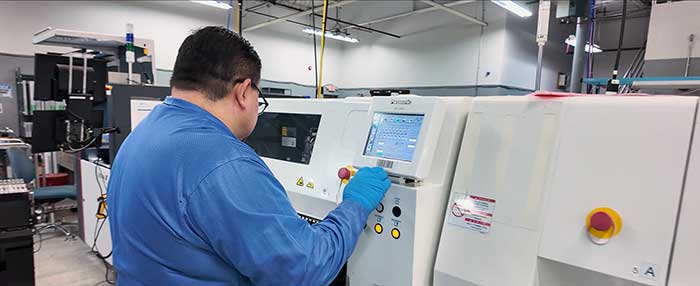Why the future of manufacturing thrives on the seamless collaboration between people and technology.

By Gustavo Sepulveda, Process Automation Business Head, Panasonic Connect North America
As AI, automation, and other technologies increase in prevalence on the factory floor, many manufacturers question what it means for the future of work. The truth is that for smart manufacturing to become a true reality – which 92% of manufacturers say is key to remaining competitive – a balance between technology and humans is necessary to keep operations running smoothly.
The National Association of Manufacturers lists incorporating smart factories as a key business imperative for 2025, noting that 50% of manufacturing leaders plan to utilize new technologies, such as artificial intelligence (AI), machine learning (ML), and industrial Internet of Things (IIoT) sensor networks, in their production facilities by next year. When implementing these new technologies into the day-to-day activities of the factory floor, seamless collaboration between skilled workers and intelligent technology is crucial for these advancements to have a lasting impact.
Let’s explore this relationship and how the combination of humans and technology helps manufacturers overcome some of the industry’s most pressing challenges, like labor shortages and rising cybersecurity concerns.
From systems that equip workers with data to drive real-time action on the factory floor to rugged mobile devices that enhance productivity by streamlining communication and reducing manual tasks, the relationship between workers and technology is key to modern manufacturing operations. Manufacturers that equip their frontline teams with the right tools are better positioned to maximize return on technology investments and remain agile in the face of uncertainty.
The role of technology should be to supplement human workers – helping them make faster, more informed decisions, reduce downtime, and increase output. For instance, real-time analytics from connected manufacturing equipment can enable predictive maintenance and prevent costly breakdowns, while rugged mobile devices can streamline communication across shifts to improve workflows. This frees up workers’ valuable time so they can focus less on time-consuming routine tasks and more on value-add activities like planning, process optimization, and continuous factory improvement.
As today’s smart manufacturing environment continues to embrace more advanced technology, manufacturers must also make an effort to cultivate a workforce that is empowered, tech-savvy, and equipped with the skills needed to operate, manage, and innovate alongside these evolving tools. Strengthening the human-tech connection enhances productivity and resilience and creates a more engaged workforce that sees technology as an enabler.
Developing a tech-savvy workforce that can effectively operate and manage advanced technologies is proving to be difficult. It’s estimated that 1.9 million manufacturing jobs could go unfilled over the next decade if talent challenges are not addressed. The same report also estimates that roles requiring higher-level skills could grow the fastest between 2022 and 2032, meaning a combination of technical manufacturing, digital, and soft skills will be needed in the industry.
To help bridge the skills gap, manufacturers need to invest in new technologies and in reskilling and upskilling programs to empower workers in the increasingly digital landscape. This includes both younger workers entering the industry and experienced employees adapting to evolving factory roles. By making manufacturing careers more tech-forward and engaging, companies can also more effectively attract the next generation of talent to help prevent workforce challenges in the future.
Fostering a culture of continuous learning within the organization can help workers keep pace with innovation and feel confident navigating a changing landscape. When companies invest in both people and technology, they future-proof their operations and build a more motivated and adaptable workforce that’s equipped for the demands of modern manufacturing.
With the increased use of technologies like AI, ML, and IIoT sensors comes advanced cybersecurity threats. As more smart factory devices and systems become connected, the factory floor becomes more vulnerable to cyberattacks that can disrupt operations, compromise sensitive data, and cost companies millions of dollars.
Cybersecurity should be a top priority for manufacturers looking to digitally transform and must be embedded into their digital transformation strategy from day one. That means implementing robust, multi-layered security frameworks, continuously monitoring systems for vulnerabilities, and ensuring both IT and operational technology (OT) teams work together to protect critical infrastructure and sensitive information.
Equally important is training staff to recognize and prevent cyber threats as part of everyday operations. This includes everything from ensuring they take the proper precautions to secure the mobile and connected devices used on the factory floor to identifying phishing attempts, using strong passwords, and following secure data-handling practices.
There are also global standards and certifications in place to help manufacturers ensure they are safeguarding their machines and operations. For example, ISA/IEC 62443 outlines best practices for implementing and maintaining electronically secure industrial automation and control systems (IACS), while ISO/IEC 27001 helps organizations identify security risks and address vulnerabilities through an established information security management framework. These standards provide a clear roadmap for building secure systems, support compliance, increase customer trust, and reduce the risk of costly breaches.
Smart manufacturing is about more than just adopting new tools and technology – it’s about creating a long-term strategy that keeps people and technology evolving together. Companies that take a holistic approach by integrating AI, automation, data, and cybersecurity with workforce development will be better positioned to thrive in a competitive and changing global market.
The smart factories of the future will be built on innovation and collaboration between people, processes, and machines. Striking the right human-tech balance will ensure that manufacturers can remain resilient, productive, and ready for whatever comes next.
Futureproofing also means being able to adapt quickly to shifts in supply chains, customer expectations, and emerging risks. It requires ongoing investment in scalable, flexible technologies as well as in the workforce that powers them. When manufacturers align digital transformation with human development, they create a more sustainable business that is built to last in the Industry 4.0 era and beyond.

About the Author:
Gustavo Sepulveda is the robotics and automation business head at Panasonic Connect. Gustavo leads a team that delivers automation solutions to the electronics and metal fabrication industries. He works with manufacturing customers to navigate their ever-changing and challenging environment. Gustavo is a passionate leader and mentor who is dedicated to shaping the next generation of workers.
Read more from the author:
How Manufacturers are Prioritizing Resilience in 2025 | RTInsights, August 4, 2025
The Importance of Cyber Resilience in Smart Manufacturing | Supply & Demand Chain Executive, June 21, 2025
In this episode, I sat down with Beejan Giga, Director | Partner and Caleb Emerson, Senior Results Manager at Carpedia International. We discussed the insights behind their recent Industry Today article, “Thinking Three Moves Ahead” and together we explored how manufacturers can plan more strategically, align with their suppliers, and build the operational discipline needed to support intentional, sustainable growth. It was a conversation packed with practical perspectives on navigating a fast-changing industry landscape.